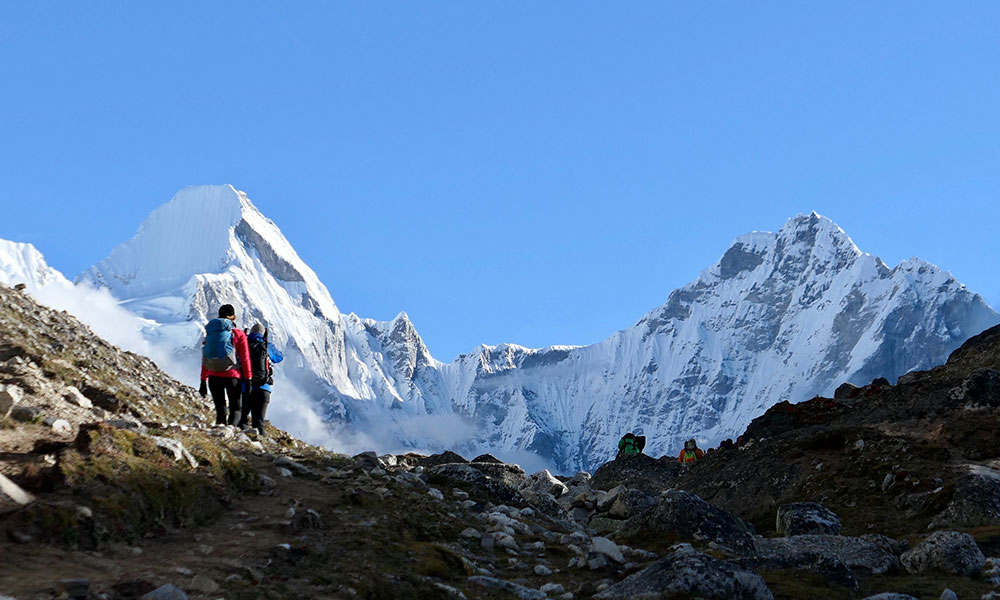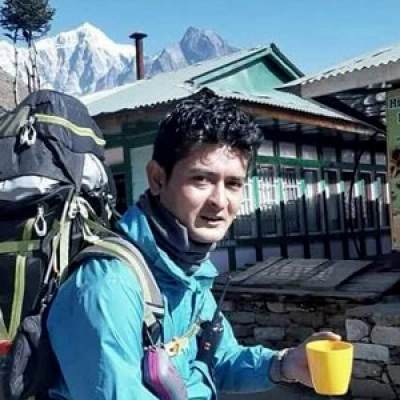Highlights Of The Trek:
- Spectacular view of Mt Everest from Gokyo Ri and Kalapatthar.
- Magnificent Views of 5 Glaciar Lakes In Gokyo Valley.
- Lush Rhododendron and Pine forests with undisturbed Flora and Fauna.
- Unique cultures, festivals, and traditions of the Sherpas.
Day to Day Itinerary:
Day 01: Arrival In Kathmandu
When you land at Tribhuvan International Airport, our representatives will pick you from the airport and escort you in a private vehicle to the hotel where you will be spending the night.
Day 02: Kathmandu Sightseeing Tour
On this day, you will visit some of the principal monuments in the city such as the famous Pashupatinath Temple, Boudhanath Stupa, Syayambhunath Stupa along with Patan and Bhaktapur Durbar Square. In the evening, there will be a short briefing by our representatives about the Everest Base Camp Chola Pass Gokyo trek.
Day 03: Kathmandu To Lukla to Phakding (2700 m) (3 hrs)
Early morning flight to Lukla (2860 m) from Kathmandu. After landing in Lukla, we begin our trek and head to Phakding (2610 m) which takes roughly about 3 hours. After reaching Phakding, we can further climb to Gompa to view the first sights of the peaks. We stay the night at Phakding.
Day 04: Phakding to Namche Bazaar (3440 m) (5-6 hrs)
We start our trek early in the morning, following the route of Dudh Koshi River and reach Zamphuti. After we finish crossing about five suspension bridges, we climb up steeply to Jorsale which leads us to Namche at roughly 5-6 hours. Overnight stay at Namche Bazaar.
Day 05: Acclimatization Day At Namche Bazaar (3440 m)
Since it is a trek at high altitude, we need our body to get acclimatized to the local climate. So, we take a day off and hike around some of the famous places around Namche bazaar such as Everest View Hotel, Khunde and Khumjung village.
Day 06: Trek To Tengboche (3790 m) (5 hrs)
After a quick meal, we leave Namche bazaar and walk for some time and then descend through a light settlement in Sanasa into Dudh Koshi River situated at Phunkithanka. After we cross the bridge, we climb steeply through the pine forests into Tengboche (3790 m). We finally stay the night at Tengboche.
Day 07: Trek From Tengboche To Dingboche (4350 m) (5-6 hrs)
We start by descending through a beautiful forest into Debuche, then we cross an exciting suspension bridge on the Imja Khola and continue our trek climbing to Pangboche. The uphill journey eventually leads us to Dingboche. After about 5 to 6 hrs of trekking, we finally stay overnight at Dingboche.
Day 08: Acclimatization Day At Dingboche (4350 m)
We need to let our body acclimatize to the surroundings. So, we take a light hike to Chhukung valley and further into Chukkung Ri (5445m) which offers fantastic views of Everest, and it’s other surrounding mountains. We then descend back down to Dingboche and stay overnight at Dingboche.
Day 09: Trek From Dingboche To Lobuche (4910 m) (5 hrs)
We start the day with a light trek through an easy trail for an hour or so finally reaching Thugla, which stands at 4600 m. We will have lunch here and then prepare ourselves for a much more steeper and challenging trail for an hour or two. We continue our journey and finally reach Lobuche at about 5-6 hours.
Day 10: Trek To Everest Base Camp (5365m) Then Back To Gorak Shep (5180m) (7-8 hrs)
We take a 2 hour’s hike in the morning to Gorak Shep which lies at an altitude of 5180m. When we reach Gorakshep, after having our lunch, we continue our hike to the base camp. After some time we arrive into the Everest base camp which stands at the height of 5180m. After some refreshments and well-deserved photographs, we descend back to Gorakshep.
Day 11: Hike To Kala Pattar (5545 m) And Trek Back To Dzongla (4620 m) (7 hrs)
We will start the trek early in the morning to Kalapattar to get the sunrise view over the Himalayas. After reaching Kalapatthar (5555m), we can view the world’s highest peak directly ahead of us and surrounding us are all the other mountain giants such as Lhotse, Nuptse, Pumori, and many others. We continue down to Gorakshep and then descent downwards to Lobuche eventually making our way to Dzongla to spend the night.
Day 12: Dzongla To Thangna (4650 m) (5 hrs)
After an early breakfast, we start our trek walking along the flat stone path to Chong La Pass at 5420 m. If you happen to visit it during the best season, the glaciers provide unforgettable views. After visiting Cho La Pass, we descend our way down to Phedi from where we climb a little uphill to reach Thangna. We will be staying overnight in Thangna.
Day 13: Trek To Gokyo (4800 m) And Explore Gokyo Valley.
After a light breakfast, we make our way to Gokyo. It takes roughly 2-3 hours to reach Gokyo. We walk along the glacier route which leads us to the first lake of Gokyo and finally into the Gokyo Valley.We spend the remaining day exploring the Gokyo Valley and spend overnight in Gokyo.
Day 14: Climb Gokyo Ri (5483 m) And Then Trek Down To Dole (4410 m) (6-7 hrs)
One of the main highlights of the trek is the Gokyo Ri. It offers spectacular views of Everest and its neighboring giants. When you reach the top, you have magnificent views of the Ngozumpa glacier, Gokyo valley, and the surrounding mountains. After spending some time out there, we trek down to Dole (4410 m) where we will be spending the night.
Day 15: Trek To Namche Bazaar (3440 m) (7 hrs)
The trek from Dole to Namche Bazaar takes approximately about 7 hours. On this course, we pass through some lush rhododendron and pine tree forests. We also travel through Khumjung Village on our way to Namche Bazaar.
Day 16: Trek To Lukla (2860 m) (5-6 hrs)
Finally, we come to the final day of our trek. We start early and travel to Phakding from Namche, which takes roughly 5-6 hours. Then we start a light walk through the forests and Sherpa villages which brings us back to Lukla where we spend the night in a hotel.
Day 17: Flight Back To Kathmandu From Lukla
An early morning flight from Lukla takes us back to the capital. Out of your plane window, you can view the spectacular views of the mountains one last time and bid farewell, reminiscing your time during the trek, as the ebc chola pass gokyo trek comes to an end.
Day 18: End Of The Tour
It’s time to say goodbye! After a quick meal, our airport representatives will drop you off at the airport, wishing you a safe journey with a hope to see you back soon!

Best Time for EBC Chola Pass Gokyo Trek
The Everest Region is not suitable for treks thought the year. Rain, avalanches, landslides and snow-capped trails create unpleasant circumstances.
So, it’s best that you take this ebc chola pass gokyo trek anytime between March and May or September to December. March to May is the spring season, so the flowers will be blooming in their full colors, making the scenery more beautiful.
You don't need to be worrying about the rainfall either, because it rarely rains there during the springtime.
September to December is also a favorable time when the winter is just around the clock. You can feel the natural Himalayan climate up in the mountains. But, I do recommend that you wear thick clothes as the weather is freezing when the sun goes down.
Contact us if you need any information regarding the trek.
How Difficult is EBC Chola Pass Gokyo Trek?
This EBC chola pass gokyo trek is more adventurous and challenging than most regular treks. You have to climb high altitudes and steep landscapes, so your stamina plays a vital role here.
Also, the elevation creates a problem for a lot of people. If you’re a little weak in stamina, you might want to consider taking lighter treks or exercising before taking this trek.
But, if you're a trekking enthusiast who has pretty stable health and good stamina, you can take up this trek.
A lot of people of different age groups take up this ebc chola pass gokyo trek, and even though it is somewhat challenging, the views you get to observe compensates it all.
Note: If you are under medications or have any other medical conditions, you should consult your physician before taking up the trek.

Highest Point during EBC Chola Pass Gokyo Trek
The highest point we will be traveling to is Kala Pattar, which stands at an elevation of 5555m. This point offers panoramic views of Mt. Everest and its gigantic neighboring mountains.
Contact us if you need any information regarding the trek.






